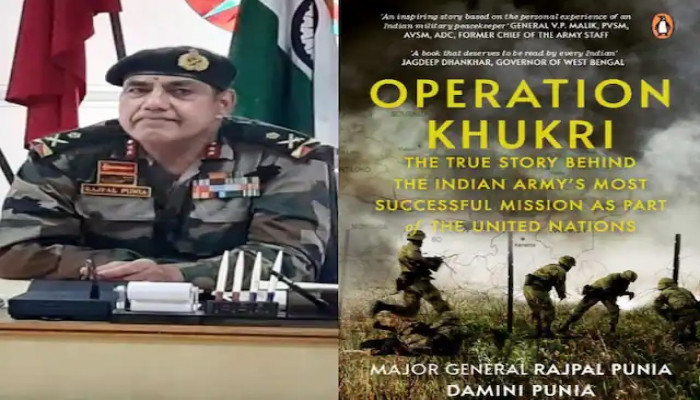Operation Khukri
- In Book Reviews
- 06:27 PM, Feb 20, 2022
- Venkatesh Kikkeri
‘Operation Khukri’ by Major General Rajpal Punia and Damini Punia is a spellbinding account of a successful military operation by the Indian Army at Kailahun City, in the Eastern Province of Sierra Leone, the country in West Africa ravaged by a prolonged civil war.
A brief background of the Sierra Leone conflict is a must to understand the role the Indian Army played under the United Nations’ (UN) banner. The conflict in Sierra Leone dates back to 1991 when fighters of the Revolutionary United Front launched a war to overthrow the Government then ruling Sierra Leone. Even after repeated interventions by Economic Community of West African States, the UN appointed Special Envoys and UN Observer Missions, peace eluded Sierra Leone. As per the Executive Summary to United Nations Development Programme Evaluation Office’s “Evaluation of UNDP assistance to conflict affected countries – Case Study Sierra Leone”, more than 70,000 people lost their lives and 2.6 million were displaced due to the civil war. The rebel movement called the Revolutionary United Front (RUF) adopted an inhuman and a barbaric approach towards the civil population. The Lome Peace Agreement was signed by all the parties to the Sierra Leone conflict including RUF during July 1999. The parties to the conflict also requested an expanded role for the United Nations Observer Mission in Sierra Leone (UNOMSIL). Thus was initiated the UNAMSIL – United Nations Mission in Sierra Leone – during October 1999 as a peacekeeping mission with approximately 6,000 military personnel to oversee the implementation of the Lome Peace Agreement. The agreement signed by RUF, amongst others, stated that the RUF was willing to lay down weapons to a neutral force of the United Nations. Thus, the Indian Army was given the proud privilege of setting up a mission in Sierra Leone (at Kailahun) to aid in establishing peace. The role of the Indian Army was to commence the Disarmament, Demobilisation and Rehabilitation (DDR) programme of the RUF rebels.
It was at Kailahun where the Indian Army’s peacekeeping unit under UNAMSIL was held hostage by the RUF approximately for a period of 90 days during May – July 2000. Apparently, a firing incident involving Kenyan peacekeepers and an UN helicopter gunship in which about twenty RUF soldiers lost their lives was the trigger that led to the hostage situation. The RUF had held the entire UNAMSIL soldiers hostage including the Indian Army contingent. Laying down the weapons and surrendering to the RUF was the main condition on which the soldiers held as hostage were to be released. While most of the peacekeeping contingents from other countries under UNAMSIL laid down their arms, the Indian peacekeeping contingent refused to lay down its arms. Major General Rajpal Punia, one of the authors, who as Company Commander then, orchestrated Operation Khukri to fight and successfully emerge from out of the hostage crisis.
This book is a thrilling first hand account of a successful and daring mission executed to uphold the honour of the Indian Army. This is a gripping tale of how 233 Indian Soldiers fought for the honour of the Indian Army without laying down their weapons unlike contingents from other countries. Most of the other peacekeeping contingents had surrendered to the RUF.
The book is racy and the reader can live through the experience of the author as a Company Commander, as a soldier, as an officer commanding more than 200 personnel and as a duty-bound olive green wearing Major, who is devout as well.
The narration is simple yet engrossing and pumps up the adrenaline. The authors explain in detail how the Indian Army was successful in winning the hearts and minds of the people of Kailahun before the commencement of the Disarmament Demobilisation Reintegration (DDR) programme as well as the confidence of the RUF too before the two unfortunate firing incidents which led to the hostage crisis. Putting down this book is next to impossible due to the authors’ blow by blow account of the entire operation. The reader is given to understand how tough the conditions were for the Indian Army on an overseas mission.
The authors leave no stone unturned when they explain how invincible the Indian Army is, as an organisation with its soldiers trained to adapt to any situation in no time. This training and invincibility were the key factors in Operation Khukri’s success.
Some of the traits of the men in olive green as narrated by the authors are truly awe inspiring. For instance, the authors emphasise that “Surrender, the nine-letter contemptible word, was off limits from the day, the Indian Soldiers don their uniform. Death is not an outcome to be dreaded, but the idea of surrender is appalling because of what dies inside us while we are still alive”! It is because of this value system that Major General Punia’s 233 men chose to fight with whatever weapons they had instead of laying down their arms.
It is also interesting to read how despite being invincible, the Major General was also a devout individual. The book is filled with instances of his respect to the unknown forces not in any individual’s control but which decides the future course of everybody’s actions and events. To quote one such instance, the authors narrate that as a routine the Major General used to step out only after seeking the blessings of Maa Durga at the Company Temple in Kailahun. On the day of them taken as hostages, he had stepped out in a hurry without seeking the blessings of the Goddess!
The peacekeeping contingent comprising soldiers from 14 Mechanised Infantry (16 Jammu and Kashmir Rifles) and 5/8 Gorkha Rifles of the Indian Army was successful in winning the hearts and minds of the people of Kailahun before the commencement of DDR programme of the RUF rebels. The provisioning of drinking water and the services of a doctor to the local population reveals the humane qualities of the Indian Army. This brought the Indian Army closer to the local population especially to the head of the Chiefdom known as the “Papa Giema”.
In a critical turn of events, the Indian Army had to fight against these people to extricate itself from the hostage situation. In the closing remarks, Major General Rajpal Punia, with a very heavy heart, laments that he had to fight with the people – whom he loved at Kailahun and whom he had brought closer to peace – to uphold the honour of the country one is devoted to. He assumes himself to be standing in the witness box with blood-stained hands representing the soldier who performed his duty, leaving the seat of judgement open to the readers. He assures that any verdict would be humbly accepted by him. (This is reminiscent of the dilemma faced by Arjuna and Dharmaraja in Mahabharat.) The verdict is loud and clear. The soldier performed his duty to the T to uphold the honour of the Indian Army and the Nation.
General V P Malik, former Chief of Army Staff, in his book Kargil - From Surprise to Victory exclaims thus, “Soldiers are quickly forgotten after a war or a crisis is over. That is part of our post-independence strategic culture”! Continuing he says, “These legendary tales deserve mention not only in our military history books but also in school text books to serve as an inspiration for younger people. We must remember that those who fight for the nation and sacrifice their lives deserve memory and recognition. It sustains their families much more than any monetary compensation. It also sustains patriotism and contributes to nation building”. This book is about one such tale that every Indian should be aware and be proud of.
One of the authors Damini Punia acknowledges that it is unfortunate people are not aware of an operation that transpired a year after the Kargil War. As a part of building favourable narratives, if the Americans can create a celluloid spectacle, ‘Black Hawk Down’, out of a failed US raid on Mogadishu in 1993 to capture the militia leader Mohamed Farrah Hassan Aidid, we Indians should at least read and disseminate the heroic deeds of our Armed Forces.
Operation Khukri, a spine-chilling account of one of the most successful operations of the Indian Army is a must read.
Reference:
- peacekeeping.un.org/mission/past/unamsil/background.html
Image source: ABP News







Comments